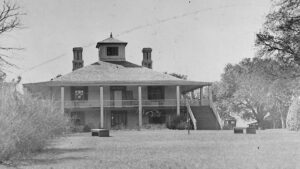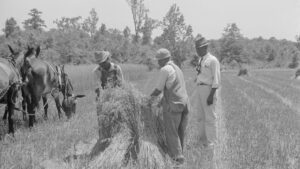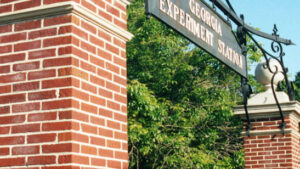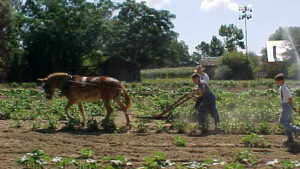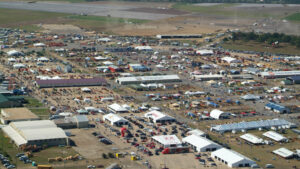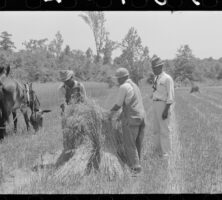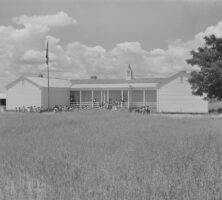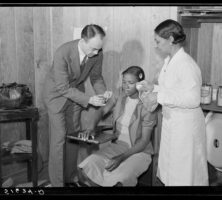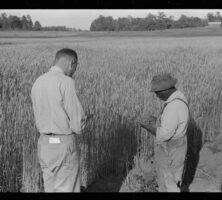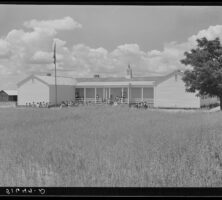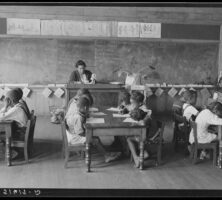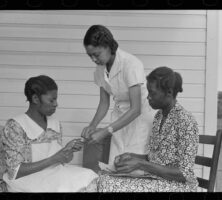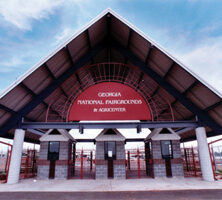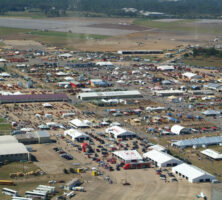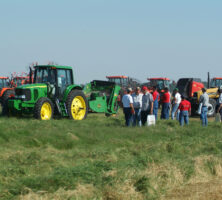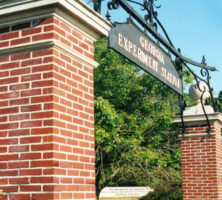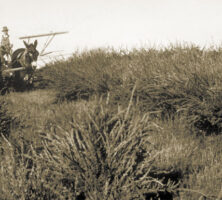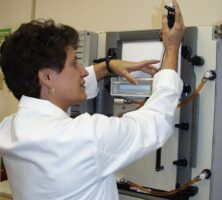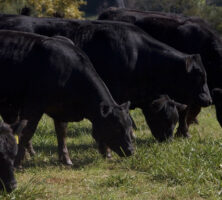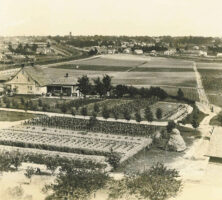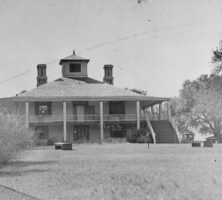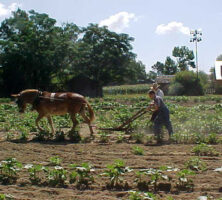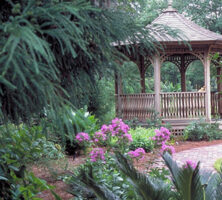The New Georgia Encyclopedia is supported by funding from A More Perfect Union, a special initiative of the National Endowment for the Humanities.
Alonzo Fields (far right), the farm supervisor at the Flint River Farms Resettlement Community in Macon County, directs the harvesting of oats in 1939. Flint River Farms was an experimental planned community established in 1937 for African American sharecroppers.
Courtesy of Library of Congress, Prints and Photographs Division, Farm Security Administration - Office of War Information Photograph Collection, #LC-USF33- 030402-M1 [P&P].
The New Georgia Encyclopedia does not hold the copyright for this media resource and can neither grant nor deny permission to republish or reproduce the image online or in print. All requests for permission to publish or reproduce the resource must be submitted to the rights holder.
The school building at the Flint River Farms Resettlement Community, an experimental farm established in Macon County for African American sharecroppers, included a schoolhouse, teacher's residence, and related buildings.
Courtesy of Library of Congress, Prints and Photographs Division
The New Georgia Encyclopedia does not hold the copyright for this media resource and can neither grant nor deny permission to republish or reproduce the image online or in print. All requests for permission to publish or reproduce the resource must be submitted to the rights holder.
The New Georgia Encyclopedia does not hold the copyright for this media resource and can neither grant nor deny permission to republish or reproduce the image online or in print. All requests for permission to publish or reproduce the resource must be submitted to the rights holder.
Dr. Thomas M. Adams and project nurse Lillie Mae McCormick, pictured in 1937, administer a typhoid shot in the health clinic at the Flint River Farms Resettlement Community in Macon County.
Courtesy of Library of Congress, Prints and Photographs Division, Farm Security Administration - Office of War Information Photograph Collection, #LC-USF34- 051634-D [P&P] LOT 1541.
The New Georgia Encyclopedia does not hold the copyright for this media resource and can neither grant nor deny permission to republish or reproduce the image online or in print. All requests for permission to publish or reproduce the resource must be submitted to the rights holder.
Project manager Amos Ward (left?) and Farm Security Administration borrower Simon Joiner inspect wheat in 1939 at the Flint River Farms Resettlement Community in Macon County. A variety of crops, including wheat, oats, cotton, pecans, and peaches were grown at the farms.
Courtesy of Library of Congress, Prints and Photographs Division, Farm Security Administration - Office of War Information Photograph Collection, #LC-USF33- 030398-M4 [P&P] LOT 1541.
The New Georgia Encyclopedia does not hold the copyright for this media resource and can neither grant nor deny permission to republish or reproduce the image online or in print. All requests for permission to publish or reproduce the resource must be submitted to the rights holder.
Students, pictured in 1939, gather outside the schoolhouse at the Flint River Farms Resettlement Community in Macon County. A field of oats grows in front of the school.
Courtesy of Library of Congress, Prints and Photographs Division, Farm Security Administration - Office of War Information Photograph Collection, #LC-USF34- 051647-D [P&P] LOT 1541.
The New Georgia Encyclopedia does not hold the copyright for this media resource and can neither grant nor deny permission to republish or reproduce the image online or in print. All requests for permission to publish or reproduce the resource must be submitted to the rights holder.
A classroom of first graders is pictured in 1939 at the Flint River Farms Resettlement Community in Macon County. The school opened to elementary-age children in 1938, and by 1946 it offered classes in all twelve grades.
Courtesy of Library of Congress, Prints and Photographs Division, Farm Security Administration - Office of War Information Photograph Collection, #LC-USF34- 051617-D [P&P] LOT 1541.
The New Georgia Encyclopedia does not hold the copyright for this media resource and can neither grant nor deny permission to republish or reproduce the image online or in print. All requests for permission to publish or reproduce the resource must be submitted to the rights holder.
Evelyn M. Driver (center) instructs students in home economics and management in 1939 at the Flint River Farms Resettlement Community in Macon County.
Courtesy of Library of Congress, Prints and Photographs Division, Farm Security Administration - Office of War Information Photograph Collection, #LC-USF33- 030379-M3 [P&P] LOT 1541.
The New Georgia Encyclopedia does not hold the copyright for this media resource and can neither grant nor deny permission to republish or reproduce the image online or in print. All requests for permission to publish or reproduce the resource must be submitted to the rights holder.
The New Georgia Encyclopedia does not hold the copyright for this media resource and can neither grant nor deny permission to republish or reproduce the image online or in print. All requests for permission to publish or reproduce the resource must be submitted to the rights holder.
The New Georgia Encyclopedia does not hold the copyright for this media resource and can neither grant nor deny permission to republish or reproduce the image online or in print. All requests for permission to publish or reproduce the resource must be submitted to the rights holder.
The main entrance of the Georgia National Fairgrounds and Agricenter, located in Perry, is pictured in 1990. The facility hosts the Georgia National Fair each October, in addition to a variety of sporting and agricultural events throughout the year.
Courtesy of Atlanta Journal-Constitution.
The New Georgia Encyclopedia does not hold the copyright for this media resource and can neither grant nor deny permission to republish or reproduce the image online or in print. All requests for permission to publish or reproduce the resource must be submitted to the Atlanta Journal-Constitution.
The New Georgia Encyclopedia does not hold the copyright for this media resource and can neither grant nor deny permission to republish or reproduce the image online or in print. All requests for permission to publish or reproduce the resource must be submitted to the rights holder.
The Sunbelt Agricultural Exposition, held in Moultrie each year during the third week of October, features crop, livestock, and equipment demonstrations. The expo, which brings in an estimated $30 million to the area each year, attracted 200,000 visitors in 2005.
Photograph by Bob Parker. Courtesy of Sunbelt Agricultural Exposition
The New Georgia Encyclopedia does not hold the copyright for this media resource and can neither grant nor deny permission to republish or reproduce the image online or in print. All requests for permission to publish or reproduce the resource must be submitted to the rights holder.
New farm equipment is demonstrated in a field during the 2005 Sunbelt Agricultural Exposition. Potential buyers have the opportunity to test drive all-terrain vehicles, tractors, and trucks during the weeklong annual event in Moultrie.
Photograph by Branch Carter. Courtesy of Sunbelt Agricultural Exposition
The New Georgia Encyclopedia does not hold the copyright for this media resource and can neither grant nor deny permission to republish or reproduce the image online or in print. All requests for permission to publish or reproduce the resource must be submitted to the rights holder.
The New Georgia Encyclopedia does not hold the copyright for this media resource and can neither grant nor deny permission to republish or reproduce the image online or in print. All requests for permission to publish or reproduce the resource must be submitted to the rights holder.
Located in Griffin, the Georgia Experiment Station is one of three agricultural experiment stations in the state operated by the University of Georgia College of Agricultural and Environmental Sciences.
Courtesy of Jay Bauer, University of Georgia College of Agricultural and Environmental Sciences
The New Georgia Encyclopedia does not hold the copyright for this media resource and can neither grant nor deny permission to republish or reproduce the image online or in print. All requests for permission to publish or reproduce the resource must be submitted to the rights holder.
A researcher at the Georgia Experiment Station in Griffin plows a field behind a three-mule team in 1900. Around this time, scientists at the station developed the deep furrow method of planting winter oats, a technique that saved millions of dollars for farmers in the South.
Courtesy of University of Georgia College of Agricultural and Environmental Sciences
The New Georgia Encyclopedia does not hold the copyright for this media resource and can neither grant nor deny permission to republish or reproduce the image online or in print. All requests for permission to publish or reproduce the resource must be submitted to the rights holder.
Tracie Jenkins, a geneticist at the Georgia Experiment Station in Griffin, studies the genetic makeup of termites, a major urban pest in the South. Her work has documented four different species of termites in Georgia.
Courtesy of University of Georgia College of Agricultural and Environmental Sciences
The New Georgia Encyclopedia does not hold the copyright for this media resource and can neither grant nor deny permission to republish or reproduce the image online or in print. All requests for permission to publish or reproduce the resource must be submitted to the rights holder.
The first formulated feed diets for dairy and beef cattle in Georgia were discovered by scientists at the Georgia Experiment Station in Griffin in the early twentieth century.
Image from UGA CAES/Extension
The New Georgia Encyclopedia does not hold the copyright for this media resource and can neither grant nor deny permission to republish or reproduce the image online or in print. All requests for permission to publish or reproduce the resource must be submitted to the rights holder.
Gil Landry, a turfgrass specialist at the Georgia Experiment Station in Griffin, researches the use of sod to control soil erosion along the state's roadways.
Courtesy of University of Georgia College of Agricultural and Environmental Sciences
The New Georgia Encyclopedia does not hold the copyright for this media resource and can neither grant nor deny permission to republish or reproduce the image online or in print. All requests for permission to publish or reproduce the resource must be submitted to the rights holder.
The Georgia Experiment Station in Griffin, pictured around 1907, was established in 1888 to perform agricultural research in such areas as fertilizers, soil erosion, and crop varieties. These studies led to the modernization of agricultural techniques in the South.
Image from UGA CAES/Extension
The New Georgia Encyclopedia does not hold the copyright for this media resource and can neither grant nor deny permission to republish or reproduce the image online or in print. All requests for permission to publish or reproduce the resource must be submitted to the rights holder.
The New Georgia Encyclopedia does not hold the copyright for this media resource and can neither grant nor deny permission to republish or reproduce the image online or in print. All requests for permission to publish or reproduce the resource must be submitted to the rights holder.
Fruitland Manor, the home of horticulturist Louis Berckmans, stands on the grounds of Berckmans Nursery. Berckmans and his son Prosper founded the nursery in 1858 and introduced a range of new fruit varieties and shrubs to the Southeast.
Courtesy of Georgia Archives, Vanishing Georgia, # ric035.
The New Georgia Encyclopedia does not hold the copyright for this media resource and can neither grant nor deny permission to republish or reproduce the image online or in print. Requests for permission to publish or reproduce the resource should be submitted to the Georgia Archives.
The Augusta National Golf Club, home of the Masters Tournament, was established by golfer Bobby Jones on the former grounds of Berckmans Nursery in 1931. The landscaping of the golf course includes many of the ornamental plants propagated between 1858 and 1918 by Louis and Prosper Berckmans.
Image from Brett Chisum
The New Georgia Encyclopedia does not hold the copyright for this media resource and can neither grant nor deny permission to republish or reproduce the image online or in print. All requests for permission to publish or reproduce the resource must be submitted to the rights holder.
Visitors to the Georgia Museum of Agriculture and Historic Village can experience everyday nineteenth-century-style farming practices, such as mule plowing.
Courtesy of Georgia Museum of Agriculture and Historic Village
The New Georgia Encyclopedia does not hold the copyright for this media resource and can neither grant nor deny permission to republish or reproduce the image online or in print. All requests for permission to publish or reproduce the resource must be submitted to the rights holder.
The New Georgia Encyclopedia does not hold the copyright for this media resource and can neither grant nor deny permission to republish or reproduce the image online or in print. All requests for permission to publish or reproduce the resource must be submitted to the rights holder.
The New Georgia Encyclopedia does not hold the copyright for this media resource and can neither grant nor deny permission to republish or reproduce the image online or in print. All requests for permission to publish or reproduce the resource must be submitted to the rights holder.
More than 10,000 people a year visit the Bamboo Farm and Coastal Gardens, which is open to the public. Visitors can tour the educational display gardens or enjoy the gazebo.
Courtesy of Georgia Department of Economic Development.
The New Georgia Encyclopedia does not hold the copyright for this media resource and can neither grant nor deny permission to republish or reproduce the image online or in print. Requests for permission to publish or reproduce the resource may need to be submitted to the Georgia Department of Economic Development.
In 1890 Mrs. H. B. Miller planted three bamboo plants, obtained from Cuba, at a site in southwestern Savannah. Today 140 varieties of bamboo grow at the Bamboo Farm and Coastal Gardens.
Image from UGA CAES/Extension
The New Georgia Encyclopedia does not hold the copyright for this media resource and can neither grant nor deny permission to republish or reproduce the image online or in print. All requests for permission to publish or reproduce the resource must be submitted to the rights holder.

